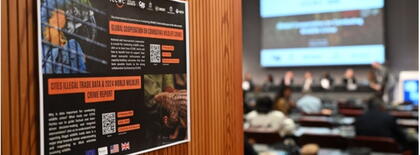Geneva, 10 July 2020 - The United Nations Office on Drugs and Crime (UNODC) unveiled the World Wildlife Crime Report 2020 during a high-level virtual event at which statements were delivered by Ms. Ghada Whaly and Ms. Angela Me, respectively UNODC’s Executive Director and Chief of Research and Analysis Branch;Ms. Carla Montesi, Director for Planet and Prosperity of the European Commission’s Development Cooperation Directorate; Ms. Astrid Schomacher, Director for Global Sustainable Developmentof the European Commission’s Directorate for the Environment; and the CITES Secretary-General, Ms. Ivonne Higuero
The World Wildlife Crime Report 2020 was developed drawing upon the best available data provided by international bodies and enforcement authorities from around the world. This included data from the annual illegal trade reports that CITES Parties are required to submit to the Secretariat since 2017.
Parties have agreed that this data be shared with the members of the International Consortium on Combating Wildlife Crime (ICCWC) for the purposes of research and analysis on wildlife and forest crime.
ICCWC is a collaboration between five intergovernmental organizations: the CITES Secretariat, INTERPOL, UNODC, the World Bank and the World Customs Organization. Its aim is to strengthen criminal justice systems, building capacity and supporting law enforcement work to address wildlife and forest crimes at the national, regional and international levels.
The World Wildlife Crime Report 2020 contains detailed case studies on illegally traded species, illicit markets and trade flows, as well as illicit financial flows. It analyzes the status and changing trends of illegal markets, most notably illicit trafficking of rosewood, eels, reptiles, ivory, rhino horn and pangolin scales, all specimens covered by CITES.
The report shows that poaching of elephants and rhinoceroses and the prices for ivory and rhino horn have declined in recent years. However, this is in sharp contrast with the illegal trade in pangolin specimens (Manis spp., included in CITES Appendix I), which have been escalating, resulting in pangolins becoming the “most trafficked mammal in the world”.
Moreover, rosewood timber species, which are also listed in the CITES Appendices, still represent a significant share of the value of all wildlife seizures analyzed by UNODC.
The report highlights the significant rise of other illegal markets, such as for the European glass eel (Anguilla anguilla, CITES Appendix II).
Another novelty in the report lies in the increased emphasis it places on seeking to disrupt the illicit financial flows that underpin wildlife crime.
Through its case studies, the report addresses the situation concerning species that are central to Decisions adopted in 2019 at the 18th meeting of the Conference of the Parties to CITES (CoP18), providing insight that will inform the continued efforts by CITES Parties to implement these Decisions and address illegal trade.
Secretary-General Ivonne Higuero praised the depth of the report and highlighted the importance of robust data for such research efforts. She noted the important role of the annual reports on illegal trade submitted by CITES Parties and the joint efforts between the CITES Secretariat, UNODC, and other ICCWC partners, to get the most out of this data.
“Accurate data is the bedrock of policymaking. The 2020 World Wildlife Crime Report demonstrates the value of such data. When properly analyzed and interpreted, data can be converted into a product that truly enables its use. Few problems require as urgent a policy response, as the devastating consequences of wildlife crime, and few publications are as insightful for ongoing and upcoming responses to this form of crime as is the 2020 World Wildlife Crime Report. Rooted in the best data available, including that of CITES Parties’ annual illegal trade reports, the report provides governments with a clear picture of the situation and underscores the need to act now to conserve our most valuable species and ecosystems,” Ms. Higuero said.
The World Wildlife Crime Report 2020 represents the second detailed publication looking at the scale of wildlife trafficking flows around the world. It follows the World Wildlife Crime Report launched in 2016, which represented the first ever report of this nature.
For more information and to arrange interviews, please contact:
CITES Secretariat: Francisco Pérez, +41 22 917 1447, francisco.perezgonzalez [at] un.org (francisco[dot]perezgonzalez[at]un[dot]org)
About CITES:
The Convention on International Trade in Endangered Species of Wild Fauna and Flora (CITES) was signed on 3 March 1973 and entered into force on 1 July 1975. With 183 Parties (182 countries + the European Union), it remains one of the world's most powerful tools for wildlife conservation through the regulation of international trade in over 36,000 species of wild animals and plants. CITES-listed species are used by people around the world in their daily lives for food, health care, furniture, housing, tourist souvenirs, cosmetics or fashion. CITES seeks to ensure that international trade in such species is sustainable, legal and traceable and contributes to both the livelihoods of the communities that live closest to them and to national economies for a healthy planet and the prosperity of the people in support of UN Sustainable Development Goals.
About ICCWC:
The International Consortium on Combating Wildlife Crime (ICCWC) is a collaborative effort of the CITES Secretariat, INTERPOL, the United Nations Office on Drugs and Crime (UNODC), the World Bank and the World Customs Organization (WCO), to strengthen criminal justice systems and provide coordinated support at national, regional and international level to combat wildlife and forest crime. Since its establishment, ICCWC has delivered innovative tools and provided crucial services and technical support to the law enforcement community to strengthen responses to wildlife crime.



